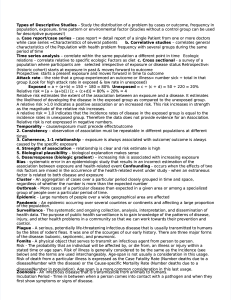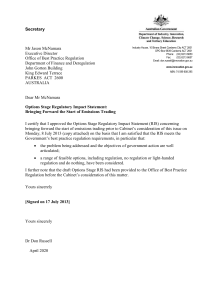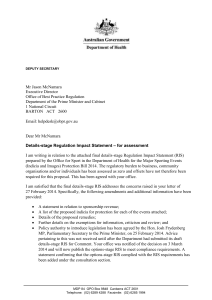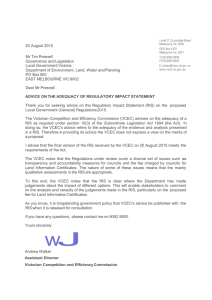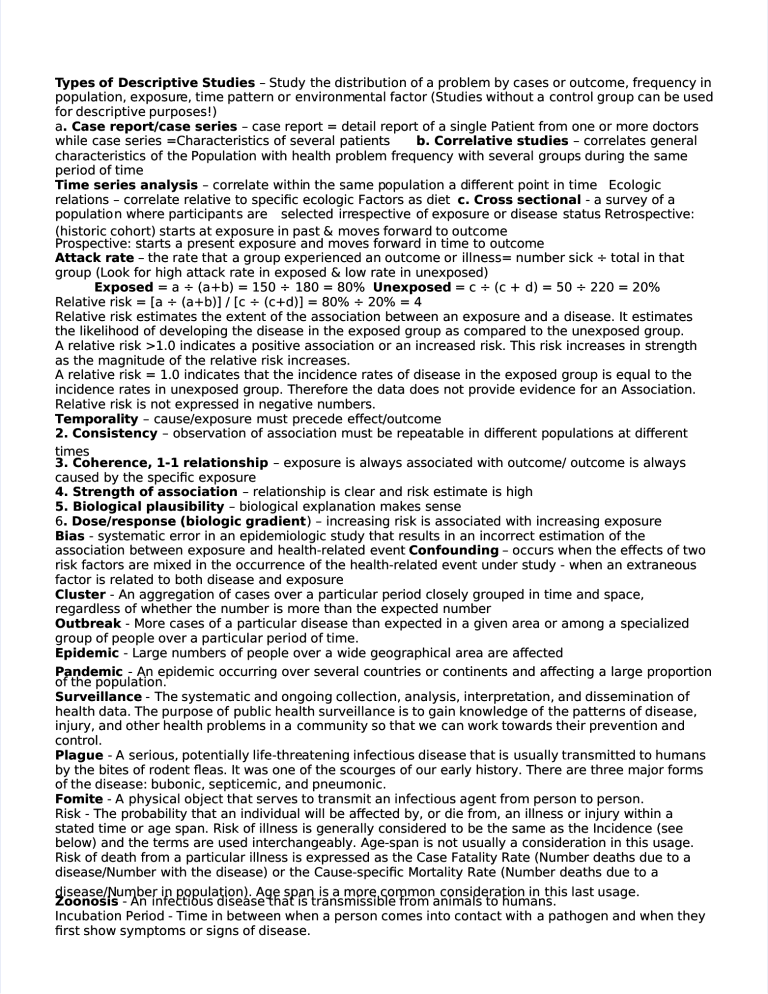
Types of Descriptive Studies – Study the distribution of a problem by cases or outcome, frequency in population, exposure, exposure, time pattern or environm environmental ental factor (Studies without a control group can be used for descriptive purposes!) a. Case report/case series – case report = detail report of a single atient from one or more doctors while case series =haracteristics of several patients b. Correlative studies – correlates general characteristics of the opulation with health problem frequency with several groups during the same period of time Time series analysis – correlate correlate within within the same population population a di"erent di"erent poi point nt in time #cologic relations – correlate relative to speci$c ecologic %actors as diet c. Cross sectional & a survey of a population populatio n where participants participant s are selected irr irrespective espective of exposure or disease status 'etrospective (historic cohort) starts at exposure in past moves forward to outcome rospective starts a present exposure and moves forward in time to outcome Attack rate – the rate that a group experienc experienced ed an outcome or illness= number sic* + total in that group (oo* for high attac* rate in exposed low rate in unexposed) Exposed = a + (a-b) = ./0 + .10 = 102 Unexposed = c + (c - d) = /0 + 330 = 302 'elative ris* = 4a + (a-b)5 6 4c + (c-d)5 = 102 + 302 = 7 'elative ris* estimates the extent of the association between an exposure and a disease8 9t estimates the li*elihood of developing the disease in the exposed group as compared to the unexposed group8 : relative ris* ;.80 indicates a positive association or an increased ris*8 <his ris* increases in strength as the magnitude of the relative ris* increases8 : relative ris* = .80 indicates that the incidence rates of disease in the exposed group is equal to the incidence rates in unexposed group8 <herefore the data does not provide evidence for an :ssociation8 'elative ris* is not expressed in negative numbers8 Temporality – cause6exposure must precede e"ect6outcome 2. Consistency – observation of association must be repeatable in di"erent populations at di"erent times . Co!erence" #$# relations!ip – exposure is always associated with outcome6 outcome is always caused by the speci$c exposure %. Stren&t! of association – relationship is clear and ris* estimate is high '. (iolo&ical plausibility – biological explanation ma*es sense . Dose/response )biolo&ic &radient) &radient ) – increasing ris* is associated with increasing exposure (ias & systematic error in an epidemiologic study that results in an incorrect estimation of the association between exposure and health&related event Confoundin& – occurs when the e"ects of two ris* factors are mixed in the occurrence of the health&related event under study & when an extraneous factor is related to both disease and exposure Cluster & :n aggregation of cases over a particular period closely grouped in time and space, regardless of whether the number is more than the expected number *utbreak & >ore cases of a particular disease than expected in a given area or among a speciali?ed group of people over a particular period of time8 Epidemic & arge numbers of people over a wide geographical area are a"ected +andemic & :n epidemic occurring over several countries or continents and a"ecting a large proportion of the population8 Surveillance & <he systematic and ongoing collection, analysis, interpret interpretation, ation, and dissemination of health data8 <he purpose of public health surveillance is to gain *nowledge of the patterns of disease, in@ury, and other health problems in a community so that we can wor* towards their prevention and control8 +la&ue & : serious, potentially life&thre life&threatening atening infectious disease that is usually transmitted to humans by the bites of rodent Aeas8 9t was one of the scourges of our early history8 <here are three ma@or forms of the disease bubonic, septicemic, and pneumonic8 ,omite & : physical ob@ect that serves to transmit an infectious agent from person to person8 'is* & <he probability that an individual will be a"ected by, or die from, an illness or in@ury within a stated time or age span8 'is* of illness is generally considered to be the same as the 9ncidence (see below) and the terms are used interchangeably8 :ge&span is not usually a consideration in this usage8 'is* of death from a particular illness is expressed as the ase %atality 'ate (Bumber deaths due to a disease6Bumber with the disease) or the ause&speci$c >ortality 'ate (Bumber deaths due to a disease6Bumber in population)8 :ge span is a more common considerati disease6Bumber consideration on in this last usage8 -oonosis & :n infectious disease that is transmissible from animals to humans8 9ncubation eriod eriod & <ime in between when a person comes into contact with a pathogen and when they $rst show symptoms or signs of disease8 Endemic Disease & resent at a continuous level throughout a population6geographic areaC constant presence presenc e of an agent6health condition within a given geographic area6populationC refer refers s to the usual prevalence preval ence of an agent6condition8 A&ent & : microbial organism with the ability to cause disease8 +ortal of Exit & : place of exit providing a way for an agent to leave the reservoir8 Dhat serve as portals of exit are often not terribly surprising, at least, once something is *nown of how and where a pathogen replicates and enters new hosts8 'espiratory infections tend to utili?e the mouth and nose as portals of exit8 : more general portal of exit occurs when an infected animal is butchered or an infected person undergoes surgery8 <he three most common portals of exit are the s*in, gastrointestinal tract, and respiratory tract8 ode of Transmission & >ethod of transfer by which the organism moves or is carried from one place to anotherC the transfer of disease&causing microorganisms microorganisms from one environment environment to another, particularly from an external environment to a susceptible individual8 <here are three general categories of transmission contact, vehicle, and vector8 +ortal of Entry & :n opening allowing the microorganism microorganism to enter the hostC the route a pathogen ta*es to enter a host8 Eust as with the portals of exit, many pathogens have preferred portals of entry8 >any pathogens are not able to cause disease if their usual portal of entry is arti$cially bypassed8 <he most common portal of entry is the mucous membrane of the respirator respiratory y tract8 Susceptible ost & : person who cannot resist a microorgani microorganism sm invading the body, multiplying, and resulting in infection8 Contact Transmission & sub&categor sub&categories ies include direct (person&to&person), indirect (fomite), or droplet8 0e!icle Transmission & transmission via a medium such as food, air, and liquid, which are al routinely ta*en into the body, and thus serve as vehicles into the body8 +rimary prevention & early intervention to avoid initial exposure to agent of disease preventing the process from starting Secondary prevention & during the latent stage (when the disease has @ust begun), process process of screening and instituting treatment may prevent progression to symptomatic disease Tertiary prevention & during the symptomatic stage (when the patient shows symptoms), intervention may arrest, slow, or reverse the progression of disease 1uaternary prevention & set of health activities to mitigate or avoid consequences of unnecessary6excessive intervention of the health system8 Social credit that legitimi?es medical intervention may be damaged if doctors donFt prevent unnecessary medical activity and its consequences8 (otulism&%orm (otulism &%orm of food poisoning caused by a neurotoxin produced by lostridium botulinum8 Sometimes found in improperly canned or preserved food8 (road$spectrum dru&&hemotherapeutic dru&&hemotherapeutic agent that is e"ective across a wide range of di"erent types of pathogens8 C!emot!erapeutic a&ent$ ompound used in the treatment of disease that *ills or inhibits the growth of microorganisms microorganisms and does so at concentrations low enough to avoid doing damage to the host8 Contact transmission&<ransmission transmission&<ransmission of an infectious agent by direct contact of the source or its reservoir with the host8 Disinfectant&:gent Disinfectant &:gent that *ills, inhibits, or removes microorganisms that may cause disease8 ost&Gody ost &Gody of an organism that harbors another organism8 <he host provides a microenvironment that supports the growth and reproduction of the parasitic organism8 ntermediate !ost&Host !ost&Host that serves as a temporary but essential environmen environmentt for the completion of a parasiteFs life cycle8 orbidity rate&Bumber rate&Bumber of individuals who become ill with a particular disease within a susceptible population during a speci$ed time period8 ortality rate&'atio rate&'atio of the number of deaths from a particular disease to the total number of cases of the disease8 +andemic&9ncrease +andemic &9ncrease in the occurrence of a disease in a large and geographically widespread population8 Sometimes called a +arasite &Irganism that lives on or within another organism (the host)8 <he relationship bene$ts the parasite and harms the host8 3eservoir&Site, 3eservoir &Site, alternate host, or carrier that harbors pathogenic organisms and serves as a source from which other individuals can be infected8 Source&ocation Source &ocation or ob@ect from which a pathogen is immediately transmitted to a host8 Toxin&>icrobia Toxin &>icrobiall product or component that at low concentrations can in@ure a cell or organism8 Transformation&>ode Transformation &>ode of gene transfer in bacteria in which a piece of JB: in the environment is ta*en up by a bacterium and integrated into the bacteriumFs genome8 0accine&reparation of *illed microorganismsC living, wea*ened (attenuated) microorganismsC inactive 0accine&reparation or attenuated virus particlesC inactivated bacterial toxinsC or components (protein, carbohydrate carbohydrate,, or nucleic acid) of the microorganism that are administered to stimulate an immune response8 Kaccines protect an individual against the pathogenic agent or substance in the future8 0ector&iving 0ector &iving organism that transfers an infective agent from one host to another8 0ector$borne 0ector$bo rne transmission transmission&<ransmission &<ransmission of an infectious pathogen between hosts by way of a vector8 0irus&9nfectious 0irus &9nfectious agent composed of a protein coat and a single type of nucleic acid8 ac*s an independent metabolism and reproduces reproduces only within a host cell8
